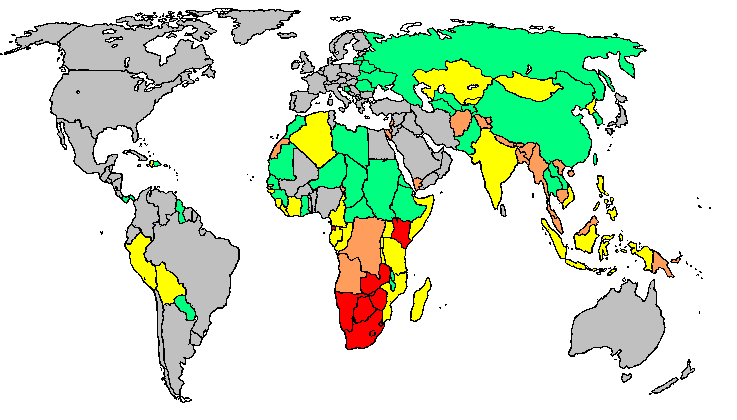Tuberculosis epidemiology and demographics: Difference between revisions
No edit summary |
Joao Silva (talk | contribs) No edit summary |
||
| Line 8: | Line 8: | ||
==Epidemiology and Demographics== | ==Epidemiology and Demographics== | ||
<!--Mandel: Tuberculosis in the United States is most frequent in geographic regions and demographic groups where AIDS is prevalent, notably urban blacks and Hispanics between 25 and 45 years of age.55--> | <!--Mandel: Tuberculosis in the United States is most frequent in geographic regions and demographic groups where AIDS is prevalent, notably urban blacks and Hispanics between 25 and 45 years of age.55--> | ||
==Age== | |||
==Gender== | |||
==Race== | |||
==Developed Countries== | |||
==Developing Countries== | |||
Revision as of 18:18, 15 September 2014
|
Tuberculosis Microchapters |
|
Diagnosis |
|---|
|
Treatment |
|
Case Studies |
|
Tuberculosis epidemiology and demographics On the Web |
|
American Roentgen Ray Society Images of Tuberculosis epidemiology and demographics |
|
Risk calculators and risk factors for Tuberculosis epidemiology and demographics |
Editor-In-Chief: C. Michael Gibson, M.S., M.D. [1]
Overview
Tuberculosis, or TB is a bacterial infection that kills 3 million people worldwide, more people than any other infection in the world. Approximately one-third of the world is infected, and 15 million people in the US. Active tuberculosis kills 60% of the time if not treated, but treatment cures 90% of patients. Most people are infected with TB have latent TB. This means that the bacteria is controlled by the body's immune system. People with latent TB do not have symptoms and cannot transmit TB to other people. However, later if the infected person has a weakened immune system (AIDS, young children, elderly, sick with other diseases, etc.), the bacteria can break out leading to active TB, or TB disease.
Epidemiology and Demographics
Age
Gender
Race
Developed Countries
Developing Countries
- In U.S., only 5% multidrug-resistant (MDR) TB is present.
- Tuberculosis (TB) is one of the world’s deadliest diseases:
- One third of the world’s population are infected with TB.
- Each year, nearly 9 million people around the world become sick with TB.
- Each year, there are almost 2 million TB-related deaths worldwide.
- TB is the leading killer of people who are HIV infected.


Cases of Tuberculosis (TB) Reported in the United States in 2005
In total, 14,097 TB cases (a rate of 4.8 cases per 100,000 persons) were reported in the United States in 2005. This represents a 3.8% decline in the rate from 2004. The 2005 TB rate was the lowest recorded since national reporting began in 1953.
Rate of Tuberculosis (TB) Declining in the United States
The TB rate is going down in the United States. But, the decrease in the percent change of the annual case rate has slowed, from an annual average of 5.6% for 1993 through 2002 to an average of 3.1% for 2003 through 2005.
Rate of Tuberculosis (TB) Compared Between U.S. Born Persons and Foreign-Born Persons Living in the United States
In 2005, the TB rate in foreign-born persons in the United States (21.8 cases per 100,000 persons) was 8.7 times greater than that of U.S.-born persons (2.5 cases per 100,000 persons).
Deaths from Tuberculosis (TB) in the United States
There were 662 deaths from TB in 2004, a 6.9% decline from 711 deaths in 2003. In 2004, mortality and morbidity statistics included 14.6 million chronic active TB cases, 8.9 million new cases, and 1.6 million deaths, mostly in developing countries. In addition, a rising number of people in the developed world are contracting tuberculosis because their immune systems are compromised by immunosuppressive drugs, substance abuse, or HIV/AIDS.
Rates of Tuberculosis (TB) for Different Racial and Ethnic Populations†
- American Indians or Alaska Natives: 6.9 cases per 100,000 persons
- Asians: 25.8 cases per 100,000 persons
- Blacks: 10.9 cases per 100,000 persons
- Native Hawaiians and other Pacific Islanders: 13.8 cases per 100,000 persons
- Hispanics or Latinos: 9.5 cases per 100,000 persons
- Whites: 1.3 cases per 100,000 persons
† For this report, persons identified as white, black, Asian, American Indian/Alaska Native, native Hawaiian or other Pacific Islander, or of multiple races are all non-Hispanic. Persons identified as Hispanic may be of any race.
Percentage of Multidrug-Resistant Tuberculosis (MDR TB)
Among all reported TB cases in the United States, the percentage of multidrug-resistant (MDR) TB cases in persons with no previous history of TB that were reported in the United States decreased from 2.5% in 1993 to 1.0% in 2005.
Since 1998, the percentage of U.S.-born patients with MDR TB has remained ≤0.7%. However, of the total number of reported primary MDR TB cases, the proportion occurring in foreign-born persons increased from 26% (105 of 410) in 1993 to 80% (76 of 95) in 2005.
TB Data Collection
The 50 states, the District of Columbia, New York City, Puerto Rico, and seven other U.S. jurisdictions in the Pacific and Caribbean, report all TB cases to CDC. These cases must meet the CDC/Council of State and Territorial Epidemiologists case definition. When cases are reported, the report includes specific information about the person with TB. This includes the patient's race, ethnicity (either Hispanic or non-Hispanic), treatment information, and, when available, drug-susceptibility test results. CDC calculates national and state TB rates and rates for foreign-born, U.S. born, and racial/ethnic populations. These calculations use U.S. census population estimates for the years 1993 through 2005.
References
- ↑ 1.0 1.1 World Health Organization (WHO). Global tuberculosis control - surveillance, planning, financing WHO Report 2006. Retrieved on 13 October 2006.